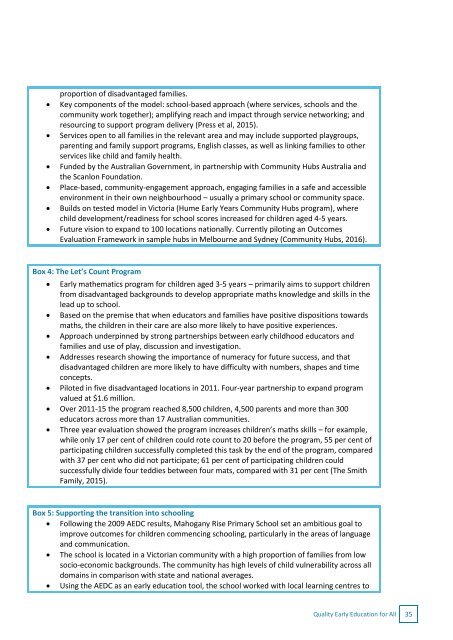Quality Early Education for All
Quality-Early-Education-for-All-FINAL
Quality-Early-Education-for-All-FINAL
Create successful ePaper yourself
Turn your PDF publications into a flip-book with our unique Google optimized e-Paper software.
proportion of disadvantaged families.<br />
Key components of the model: school-based approach (where services, schools and the<br />
community work together); amplifying reach and impact through service networking; and<br />
resourcing to support program delivery (Press et al, 2015).<br />
Services open to all families in the relevant area and may include supported playgroups,<br />
parenting and family support programs, English classes, as well as linking families to other<br />
services like child and family health.<br />
Funded by the Australian Government, in partnership with Community Hubs Australia and<br />
the Scanlon Foundation.<br />
Place-based, community-engagement approach, engaging families in a safe and accessible<br />
environment in their own neighbourhood – usually a primary school or community space.<br />
Builds on tested model in Victoria (Hume <strong>Early</strong> Years Community Hubs program), where<br />
child development/readiness <strong>for</strong> school scores increased <strong>for</strong> children aged 4-5 years.<br />
Future vision to expand to 100 locations nationally. Currently piloting an Outcomes<br />
Evaluation Framework in sample hubs in Melbourne and Sydney (Community Hubs, 2016).<br />
Box 4: The Let’s Count Program<br />
<strong>Early</strong> mathematics program <strong>for</strong> children aged 3-5 years – primarily aims to support children<br />
from disadvantaged backgrounds to develop appropriate maths knowledge and skills in the<br />
lead up to school.<br />
Based on the premise that when educators and families have positive dispositions towards<br />
maths, the children in their care are also more likely to have positive experiences.<br />
Approach underpinned by strong partnerships between early childhood educators and<br />
families and use of play, discussion and investigation.<br />
Addresses research showing the importance of numeracy <strong>for</strong> future success, and that<br />
disadvantaged children are more likely to have difficulty with numbers, shapes and time<br />
concepts.<br />
Piloted in five disadvantaged locations in 2011. Four-year partnership to expand program<br />
valued at $1.6 million.<br />
Over 2011-15 the program reached 8,500 children, 4,500 parents and more than 300<br />
educators across more than 17 Australian communities.<br />
Three year evaluation showed the program increases children’s maths skills – <strong>for</strong> example,<br />
while only 17 per cent of children could rote count to 20 be<strong>for</strong>e the program, 55 per cent of<br />
participating children successfully completed this task by the end of the program, compared<br />
with 37 per cent who did not participate; 61 per cent of participating children could<br />
successfully divide four teddies between four mats, compared with 31 per cent (The Smith<br />
Family, 2015).<br />
Box 5: Supporting the transition into schooling<br />
Following the 2009 AEDC results, Mahogany Rise Primary School set an ambitious goal to<br />
improve outcomes <strong>for</strong> children commencing schooling, particularly in the areas of language<br />
and communication.<br />
The school is located in a Victorian community with a high proportion of families from low<br />
socio-economic backgrounds. The community has high levels of child vulnerability across all<br />
domains in comparison with state and national averages.<br />
Using the AEDC as an early education tool, the school worked with local learning centres to<br />
<strong>Quality</strong> <strong>Early</strong> <strong>Education</strong> <strong>for</strong> <strong>All</strong> 35


